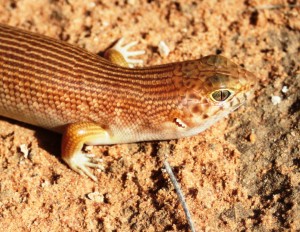Another cracking couple of weeks delivering biodiversity training was had with the Kimberley Rangers. On Karajarri country, we headed inland from Bidyadanga and were rewarded with a good taste of the astounding reptile diversity that the Great Sandy Desert supports. Among the delights were the Night Skink (Liopholis striata). Their eyes are like those of a cat. We also found a dozen recently active, though not fresh, Bilby burrows. Small mammals were very thin on the ground though, probably a result of too much late season fire, and there were at least a few cats around.
The following week in Nyikina Mangala country, over near Derby, we focussed on wetlands and were treated to an array of waterbirds, all concentrated at the end of the dry season. Here, we were able to work on our identification skills. Mankajarra and Cockatoo Creek had five different migratory shorebird species. They had recently arrived from their breeding grounds in the northern hemisphere, and ranged in size from the diminutive Red-necked Stint to the stately Black-tailed Godwit. The Kimberley is priceless, from its desert edges in the south to its wetlands scattered throughout, wildlife abounds and the ranger program helps to keep it that way.
_
For more information about the Kimberley Indigenous Ranger Biodiversity Surveys and Training, see http://www.murraywildlife.com.au/major-projects/kimberley-rangers/





